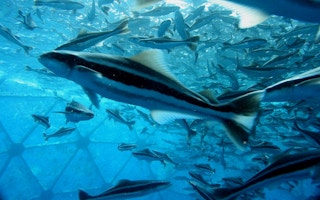More fish are being farmed to feed the world’s appetite for animal protein, but few consumers know how the salmon, tilapia or barramundi they eat lived, or died.
To continue reading, subscribe to Eco‑Business.
There's something for everyone. We offer a range of subscription plans.
- Access our stories and receive our Insights Weekly newsletter with the free EB Member plan.
- Unlock unlimited access to our content and archive with EB Circle.
- Publish your content with EB Premium.
Labelling schemes available in the market generally focus on the environmental impact of seafood production, but some advocates say this is not enough. They want labelling schemes to incorporate welfare standards, so that more of over 100 billion aquatic animals farmed each year can live “positive lives”, and more of the two to three trillion that are wild-caught experience less suffering.
The numbers are estimates by the Aquatic Life Institute (ALI), an organisation which published a guide to welfare for wild and farmed aquatic animals this month.
Backed by other animal welfare groups such as Compassion in World Farming, The Humane League and Fish Welfare Initiative, the guide calls on seafood farmers and producers to provide their animals with safe and appropriate environments. Among other things, the animals should have sufficient space and conditions that promote good psychological health, the groups said.
“This is just the beginning of a coordinated movement to draw attention to and improve existing fish product certification standards. We want all labelling schemes to take into account the welfare of aquatic animals required in the entire chain of aquaculture production, including cleaner fish, feeder animals, and broodstock, as well as the process of catching fish in the wild used for aquaculture and livestock feed,” said Becky Jenkins, ALI’s executive director.
“
This is just the beginning of a coordinated movement to draw attention to and improve existing fish product certification standards.
Becky Jenkins, executive director, Aquatic Life Institute
Compassion in World Farming has compared some popular fish labels and found that the majority do not sufficiently take animal welfare into account.
The Aquaculture Stewardship Council, for instance, does not require fish to have enrichment or set a limit to the duration fish can be starved, according to Compassion in World Farming.
Farmed fish are commonly starved before stressful procedures, such as being transported and harvested, to reduce their metabolic rate or eliminate their intestinal content.
Between June and October, the newly formed Aquatic Animal Alliance—comprising several groups including ALI—wrote to various labelling schemes urging them to incorporate aquatic animal welfare standards in their certification. The alliance wrote to GlobalG.A.P., Best Aquaculture Practices and the Aquaculture Stewardship Council, and its feedback has been well-received, said Jenkins, ALI’s head of strategic initiatives Christine Xu and creative director Jasper Wilkins. The institute was formed last year to advise and fund research on aquatic animals, which it says have been relatively neglected by animal advocates.
A GlobalG.A.P. spokesperson told Eco-Business that its integrated farm assurance standard for aquaculture has included basic animal welfare criteria since 2015. It is currently revising the standard and will publish a new version in 2022. The organisation said last month that it will “expand assurance on animal welfare for all species across the full production chain”.
Asia dominates aquaculture
Some of the Aquatic Animal Alliance’s members also work directly with farmers in Asia, which farms nearly 90 per cent of the world’s aquatic animals, according to the United Nations’ Food and Agriculture Organisation.
The Fish Welfare Initiative, for instance, is a United States-registered charity that focuses its operations on India, a major finfish producer.
India’s aquaculture sector is dominated by small- to medium-scale pond farms, said Jennifer-Justine Kirsch, research and project strategist of the Fish Welfare Initiative. Indian major carp and catfish are the most commonly farmed species groups, and the charity found poor water quality, especially low dissolved oxygen, to be a major issue.
“We will work with farmers to improve their farming practices, monitor water quality, and improve dissolved oxygen through aeration,” Kirsch said. “Our goal is to achieve institutional welfare commitments for fish and we are kickstarting 2021 with a pilot programme to improve farming conditions for rohu and catla (two types of carp).”
Another issue the charity has identified, is that the majority of fish farmed in India are slaughtered without stunning—knocked unconscious with a severe blow to the skull, or an electric current—and suffer for an extended period of time before death, Kirsch added.
But this is a problem also seen in other places and extends to wild-caught fish, said ALI’s Xu, Jenkins and Wilkins.
What about the common practice in Asia, where live seafood is displayed in tanks and containers at supermarkets and wet markets, and slaughtered fresh for customers? ALI said it is a challenging issue to tackle, even in Europe, where most carp farmed are sold alive. Just in September, Carrefour Poland agreed that it will no longer sell live carps by 2021, it noted.
“For wet markets and restaurants in Asia, a change will heavily involve consumer demand for humane slaughter practices and policy changes and enforcement from the government level. For example, at a minimum, sellers should have manual percussive stunning available prior to slaughter,” the ALI team noted.
Beyond slaughter, ALI recommends practices such as providing aquatic animals with adequate space, water quality, enrichment and appropriate food. Employees should also be trained in proper handling techniques.
The concept of a “humane fish product” remains unclear to most consumers, ALI noted. “Precisely because fish do not show facial expressions, it is more challenging to get the message across, but not impossible.”
The ALI and alliance will use the guide to continue reaching out to other labelling programmes, push for legislative reform and changes at farms and in corporate supply chains, the team said.










